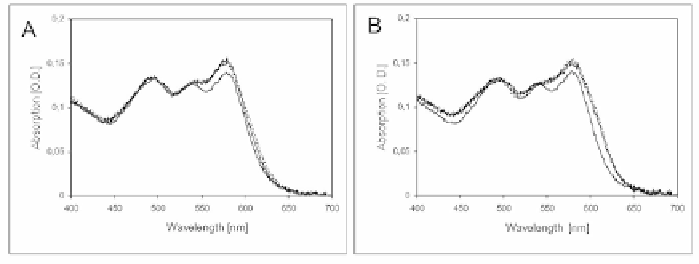Environmental Engineering Reference
In-Depth Information
showing that the fluorescence lifetimes and the relative amplitudes of the different
molecular species emitting at 600 nm are not affected by UV-B irradiation
37
.
Fig. 12.
Optical absorption spectra of agar suspensions of
B. japonicum
kept in the dark (continuous
line), irradiated with visible light (Ot 370 nm, broken line) and with UV-B (Ot 280 nm, dotted line)
for 30 min (A) and 60 min (B) (redrawn from ref.18).
The UV-B-induced inhibition of photoresponsiveness in
B. japonicum
can,
therefore, be explained in terms of a damage to some components of the photosensory
transduction chain, such as electron/proton transfer systems and/or membrane channels.
The latter hypothesis is supported by the observation that the avoiding reaction to
mechanical stimuli are reduced after 30 min and completely suppressed after 60 min of
UV-B irradiation. This inhibition, in fact, could be due to a damage at the membrane
level
18
.
Fabrea salina
do not undergo photokilling and the effects of UV-B irradiation
cannot be mediated by photodynamic reactions. In agreement with the results obtained
in
B. japonicum
, fluorescence spectra of the hypericin-like pigment of
F. salina
,
obtained by cell sonication, were unaffected by irradiation with UV-B, UV-A and
visible light
19
(Fig. 13). UV-B-caused modifications of the pigment concentration or
structure can, therefore, be ruled out.
Interesting data come from the analysis of the dose-effect curves of phototactic
sensitivity reported in Fig. 11. The increase, after irradiation, of the fluence rate required
in order to obtain half maximum response could indicate a damage to the photoreceptor
pigment molecules, with the consequence that a higher number of photons is required in
order to obtain the same response. In addition to this reduced light sensitivity,
F. salina
irradiated samples show a lower level of saturation of the phototactic response; this
suggests a damage to some parts of the sensory transduction chain, such that even high
fluence rate are not sufficient to elicit the same maximum response as in control
samples. These results, therefore, point to an impaired photosensory transduction chain
due to a possible damage both to the photoreceptor pigment and to some target molecule
involved in the dark reactions following light detection
19
.
The above-mentioned fluorescence measurements indicate that the hypericin-like
pigment of
F. salina
does not appear to be damaged by UV-B radiation; on the basis of
these experimental results, the hypothesis of the rhodopsin-like nature of the

Search WWH ::

Custom Search